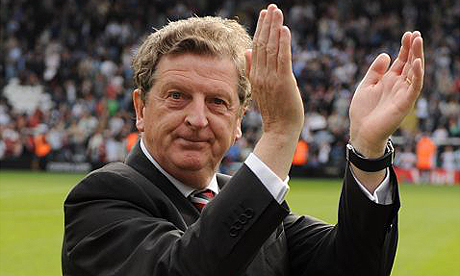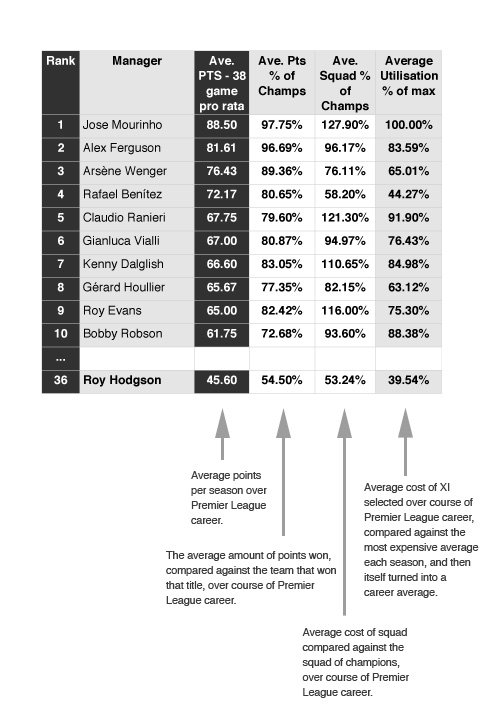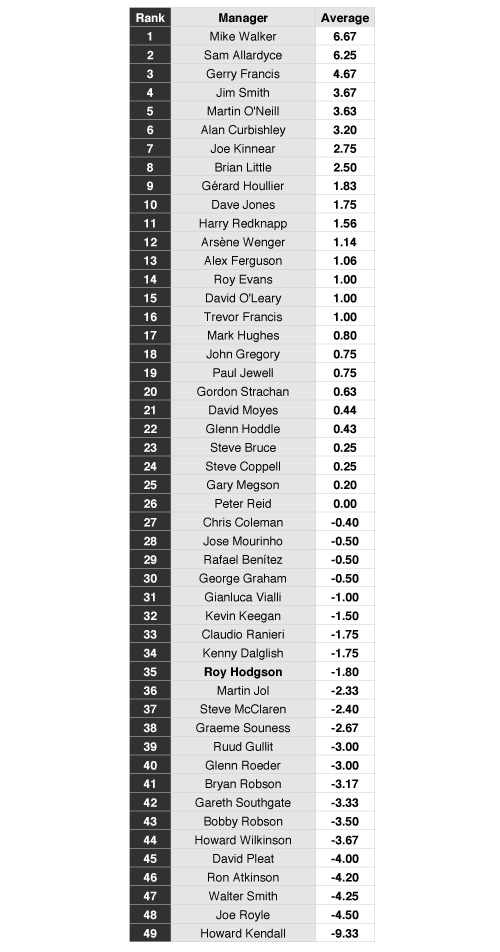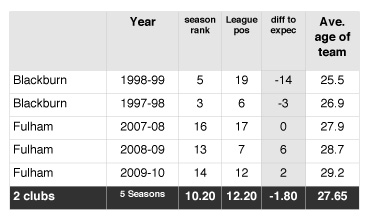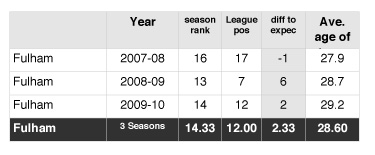At present, several members of this site are beavering away with analysis for the monumental Transfer Price Index (TPI) project, which not only looks at every signing in Premier League history (please forgive the use of the word ‘history’ in this context) in order to give a figure for any transfer fee in ‘2010 money’, but also – as part of a book we are writing – examines how each and every manager performed with the resources at his disposal.
This whole project has led to a spreadsheet with almost a million data fields, and every last aspect of a team or manager’s performance can be ranked.
Managers can then be compared fairly with each other only in terms of what they’ve achieved on similar budgets. For example, Roy Hodgson’s record should not be compared with Jose Mourinho’s. Of course, hard numbers cannot take into account the vagaries and imponderables, such as boardroom support and other clubs unsettling your players, but as I note with all my statistical work, it’s there to give an indication; paint an impressionistic picture, rather than produce a crystal-clear photograph.
From this study I have chosen to focus in on the 49 managers who have managed for more than two full seasons since the Premier League launched 18 years ago. This therefore includes all Liverpool managers; Graeme Souness has nine seasons spread across various clubs, but Evans, Houllier and Benítez only managed the Reds. (Ten years ago Evans spent a brief spell as caretaker at Hodgson’s old club, Fulham, but this was not included.)
We need to look at what Hodgson has done to date, and what can be expected based on the current situation at Liverpool; and of course, every manager is compared against his predecessor. Presumably the club think he can do a better job than Benítez, so we need to look at what the Spaniard did, too.
Hodson’s main disadvantage, when assessing his record, is the disastrous second season at Blackburn, which blots his copybook. Also, much of his best work has been done overseas, so that won’t show up here. The emergence of Manchester City means that Hodgson has one more ‘megaclub’ to contend with, and that needs to be taken into account.
What’s clear is that Liverpool recently sacked the man with the 4th-highest points average in Premier League history – which was achieved with by far the lowest relative spend out of those in the top 10 (when taken as a six-year average compared against the averages of the most expensive team, and also against the champions, in that time.)
On average, Benítez won 80.65% of the points of the champions between 2004 and 2010, with only 58.2% of their squad cost; and he did so fielding an XI that, on average, cost only 44.27% of the most expensive XI each season; the next-lowest figures are the 63.12% of his predecessor, Gérard Houllier, and the 65.01% of Arsene Wenger.
Four managers in the top 10 – Mourinho, Ranieri, Dalglish and Evans – have, on average, possessed squads more expensive than the title-winners during their active years.
Hodgson ranks way down in 36th place, although the fairly low cost of his Fulham side was in stark contrast to that at Blackburn. He averages just 45.6 points per season; interestingly, in relation to the squad cost of the champions in his five seasons, 54.5% is only fractionally lower than Benítez’s. And the average cost of the XIs he has fielded has also only been a few percent beneath the Spaniard’s figure, due to a mix of Blackburn’s greater average, and Fulham’s lower average.
A very important factor is how a manager ranks in terms of his average league position; this is then compared against how much his average XI cost, to give an ‘expected’ finishing position. If you field the 10th-most expensive side throughout the season (taken as an average over all 38 games), then you should finish 10th. (This of course doesn’t take into account wages, but more about that will be explained in the book.)
One thing the TPI study seems to suggest – although it still needs further examination – is that some managers are great at getting smaller clubs to punch above their weight, but then find the fans at bigger clubs do not accept their methods, or they simply don’t work with better players. A weight of expectation can drag anyone down.
Sam Allardyce did remarkably well at Bolton, but had a horrible time at Newcastle. Mike Walker saw Norwich punch way above their weight in the early Premier League years; but at Everton his team finished well below their expected league position. Gerry Francis worked miracles at QPR; yet he failed at Spurs. Alan Curbishley did a brilliant job at Charlton; at West Ham he made little impact. Joe Kinnear made Wimbledon a team to fear, and, with the help of a few others, Newcastle a team to play in the Championship. Mark Hughes took Blackburn to well above where they should have been; Man City well below.
I can find very few examples of managers who take that overachievement to bigger clubs and even ‘break even’ with expectations. Martin O’Neill worked wonders with Leicester, but landlocked by a glass ceiling as Aston Villa, merely keeps them where they ‘should’ be.
Harry Redknapp, who did so well at Portsmouth and West Ham (but less well at Southampton), fielded the 5th-most expensive XI, on average, last season, and Spurs came 4th. (Note: Redknapp did have the 4th-most expensive squad to pick from.) But it’s early days, with only one full season to judge his time in the biggest job of his long career to date. O’Neill fielded the 6th-most expensive XI, and they came 6th. Status quo.
Both men fared much better at smaller clubs in terms of punching above their weight, but obviously there’s more scope to do so down there; the higher you go, the less opportunities arise to ‘scalp’ someone who is having a bad season, as precious few teams do. (When Benítez finally got Liverpool to finish above Chelsea, it was ‘only’ the reigning European champions, Manchester United, that blocked his path to the title. Five mid-table teams could have a bad season, but it’s rare for more than one of what was known as the ‘big four’ to have an off year.)
This is not to say that Roy Hodgson cannot bring his overachievement at Fulham to Merseyside, just that prior experience of being plucky, hard-to-beat and relatively successful seems to have little bearing when moving up to manage one of the big boys.
At Blackburn, in the one fairly big Premier League position he had held prior to today, Hodgson’s average finishing position between 1997 and 1999 was almost 9 places below the rank of the cost of the XIs he fielded.
This takes his second season as complete; of course, he was sacked in mid November. However, he was 20th when dismissed, just before the halfway mark, and they finished 19th; so if anything, the figures are fractionally kinder, but hardly worth worrying about.
The contrast at Fulham is marked. The half-season he began with does not help his figures – a fraction below expectations (because he inherited a poor side) – but his two full campaigns saw them finish six and then two places above where expected.
In terms of all five seasons, including incomplete campaigns, he ranks 35th out of the 49: basically, the same as with average league points (36th).
Hodgson would rank 8th, if based on just his time at Fulham. But of course, this wouldn’t be fair on the other managers whose figures include the mix of success and failure. Equally, based on his Blackburn figures alone, Hodgson would sit below 47 of the 48 other managers. And that wouldn’t be fair either.
In this category, most of the title-winning managers, and Champions League contesters, are ranked between +1.14 (Wenger) and -1.75 (Dalglish). Benítez falls in the middle, at an average of half a league position (-0.5) below where expected – figures not helped by the -3 ranking last season. (Prior to that one bad year, Liverpool finished either one place above, or one place below, where they ‘should’ have).
At -1.8, Hodgson is just a fraction below the stellar names who cluster in this middle ground.
As a note to explain his surprisingly high ranking, Gérard Houllier’s time in charge of Liverpool coincided with quite a few other teams fielding more expensive XIs. Therefore he ranks highest of any Liverpool manager in this field. However, by the time Benítez took charge – and relating to what Hodgson will experience – Liverpool have fallen further behind the most expensive XIs, notably Chelsea, Manchester City and Manchester United. So while the rank is 4th, it is massively adrift of the top 3.
Conclusions
It’s fair to say that Roy Hodgson deserves the chance to do his best as Liverpool manager; he can only be judged on how he performs in this role, as far as Reds are concerned.
However, it’s vital that we get expectations in line with reality; this was my most frequent defence of Rafa Benítez who, as the figures show, spent five years keeping Liverpool punching ‘on par’ for their weight in the league (when people thought it was well below), and well above it in Europe; only to be undone by one annus horribilis.
And while I will support Roy Hodgson in the same manner as I did his predecessor, I will not idly sit back and see Benítez’s record sullied as part of that process. Roy deserves to be treated fairly, as does Benítez, even in his absence.
